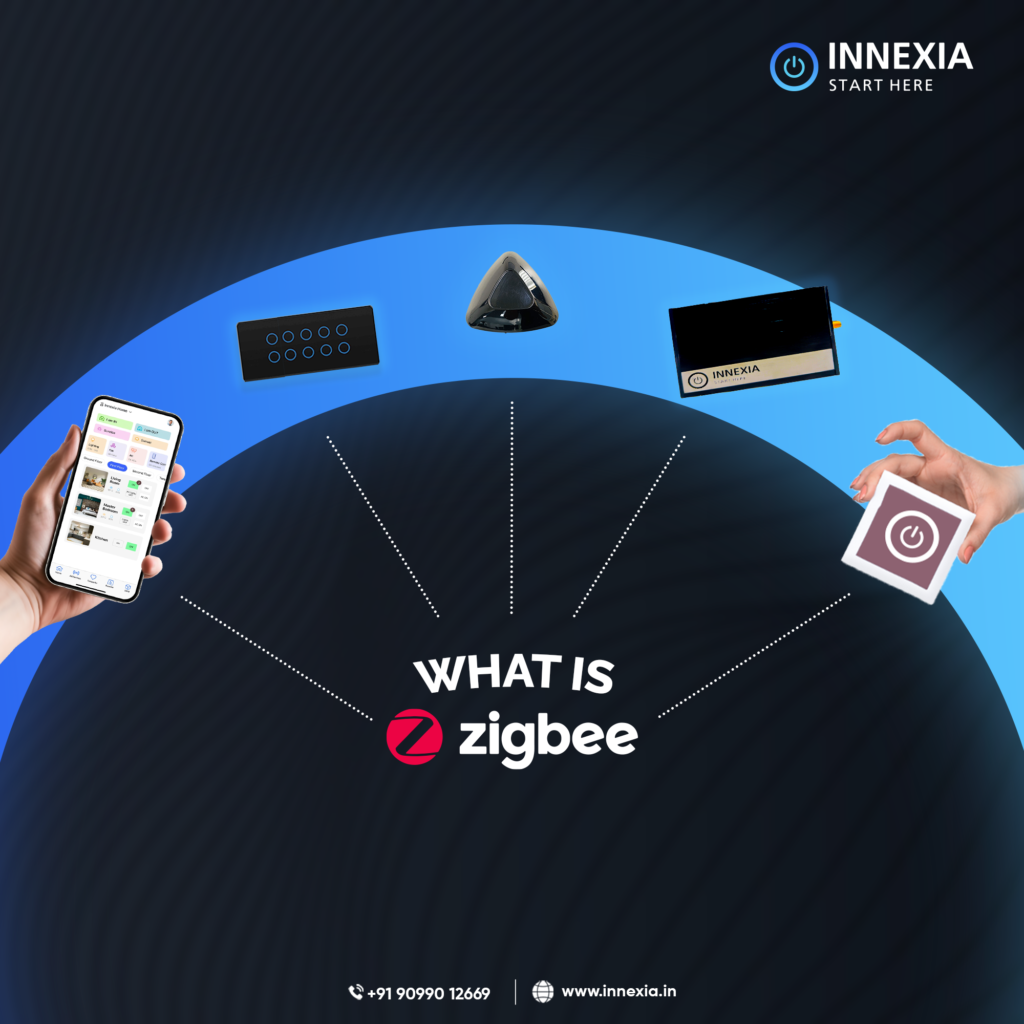In an era where constant connectivity can sometimes lead to vulnerabilities, Innexia’s approach stands as a testament to a well-rounded and holistic solution. By offering offline functionality through Zigbee technology, Innexia assures users of an automation system that remains steadfastly responsive, secure, and efficient, regardless of internet constraints.
Zigbee technology, with its low power consumption and reliable mesh networking capabilities, provides a robust foundation for Innexia’s (Smart Home Automation Company) innovative solutions, enabling seamless and secure communication among devices in a variety of environments.
What is Zigbee?

Zigbee is a wireless communication standard designed for low-power, low-data-rate, and close-proximity applications. Based on the IEEE 802.15.4 specification, Zigbee is widely used in home automation, industrial environments, and smart lighting systems. It is known for its simplicity, reliability, and ability to support a large number of devices within a network.
Simply put, Zigbee allows smart devices such as light bulbs, sockets, plugs, smart locks, motion sensors, and door sensors to communicate with each other over a Personal Area Network (PAN).
As a standalone network, this PAN can be used with devices like remote controls, battery-powered wall switches, and key fobs for simple control purposes. While this setup is perfect for basic tasks like turning on lights without needing to use a light switch, it won’t provide advanced smart capabilities.
However, when you connect the Zigbee network to a Smart Home Controller (such as those from SmartThings, Hubitat, or Homey), the full potential of home automation is unleashed.
This integration enables advanced automation and control, transforming your Smart Home Automation into a truly intelligent and responsive environment.
How Zigbee Works?

Zigbee functions as an open standard designed for cost-effective, low-power wireless mesh networks. It targets widespread deployment in applications requiring wireless control and monitoring. Leveraging the IEEE standard 802.15.4 for its physical layer and media access control, Zigbee inherently supports mesh networking and ensures secure communications by default.
Zigbee devices offer a robust and self-managing system. Unlike more complex protocols like Z-Wave, Zigbee devices are often simpler, focusing on specific tasks such as motion sensing or dimming lights rather than integrating numerous functionalities into one device.
This focused approach ensures efficient performance tailored to the specific requirements of Zigbee networks.
Why Use Zigbee?

No single smart home protocol is perfect or best suited for every application. Therefore, it’s wise to choose a Smart Home Controller that supports multiple protocols (such as Zigbee, Z-Wave, and WiFi) and integrates with other proprietary and cloud-based services. This approach ensures flexibility and compatibility with a wide range of devices.
That said, Zigbee offers several compelling reasons to make it the centerpiece of your smart home system:
Extensive Lighting Options:
Zigbee has a rich history with lighting solutions. It offers more options than any other smart home protocol, including LED bulbs, color-changing LED strips, light switches, dimmer modules, and more.
Low Power Requirements:
Zigbee devices can have a battery life of up to 10 years, making them highly efficient and low-maintenance.
Optimized for Battery Devices:
Zigbee is ideal for battery-powered devices like motion sensors, door sensors, and water sensors. These devices “sleep” to conserve power, benefiting from Zigbee’s low power consumption.
Network Stability:
Zigbee networks are self-healing. If a device goes offline, others will automatically reroute to maintain network integrity.
High Security:
Zigbee uses 128-bit AES encryption, the same level of security used by online banking services, ensuring your data is protected.
Firmware Updates:
Over-the-air (OTA) firmware updates are a key feature of Zigbee, allowing devices to be updated easily and quickly.
High Capacity:
Zigbee supports up to 65,000 devices in a single network, accommodating even the largest homes without the need for multiple networks.
Affordability:
Zigbee devices are generally very affordable, often costing less than similar devices using other technologies like Z-Wave and WiFi.
These features make Zigbee a robust and versatile choice for building a reliable and cost-effective smart home system.
What’s in a Zigbee Network?

Zigbee networks utilize three types of device roles: Coordinator, Router, and End-Device.
Coordinator
Every Zigbee network needs an administrator, and that role is filled by the coordinator. The coordinator sets up the Zigbee network, requiring one per network.
This role is usually taken by the Zigbee hub, such as the Philips Hue Bridge, Homey, or similar devices. While your coordinator doesn’t have to be a smart hub, using one is recommended for the most powerful setup.
The coordinator serves as the central point of your network. It sets permissions, allows other devices access, and coordinates your Personal Area Network (PAN). If you’re using a hub, it also links your devices to the web and apps. Hubs like Homey connect your Zigbee devices to others that might use different protocols, such as Wi-Fi, infrared, or Z-Wave.
Router
All full-function, powered (non-battery) Zigbee devices act as routers. Routers repeat the Zigbee signal, communicating with all other devices in range on the network. They “repeat” the network signal, ensuring messages are passed perfectly, as long as the devices can “hear” each other.
End-Device
End devices are reduced-function, battery-powered devices that serve as the endpoints of your network. These devices are simple and do not repeat or forward signals. They only communicate with routers and coordinators. End devices are typically used for battery-operated devices such as wireless lights and simple switches.
In most cases, your network will consist primarily of full-function devices, unless you specifically choose battery-operated end devices. This structure ensures a robust and efficient Zigbee network.
Zigbee Wireless Network Topologies
Network topology plays a crucial role in communication networks, defining how links and nodes are arranged and interconnected. In Zigbee networks, three main types of topologies are commonly used:
point-to-point, point-to-multipoint, and mesh topology. Each of these topologies influences how messages are routed and which devices are interconnected.
Mesh Topology
Zigbee’s mesh topology allows for multiple interconnections between devices, enhancing network redundancy and robustness. This decentralized structure enables each node to independently discover and maintain its connection within the network.
When nodes join or leave, the network automatically reconfigures routing paths, ensuring continuous operation and self-healing capabilities. Mesh topology is highly flexible, making it resilient to changing network conditions and node failures.
Point-to-Point
Point-to-point topology involves a direct connection between two Zigbee devices. While simpler than point-to-multipoint, this topology is less common in IoT applications due to its limited scope of connecting only two nodes directly.
Point-to-Multipoint
In a point-to-multipoint or star network topology, a central hub communicates with multiple end nodes. This setup allows a single Zigbee device to interact with a group of other Zigbee devices, facilitating efficient communication and control within the network.
These varied topologies provide Zigbee networks with flexibility to suit different application needs, from direct device-to-device communication to centralized control hubs managing multiple endpoints.
Zigbee Compatibility and Interoperability
In the early years, Zigbee smart devices often used “closed” protocols at the application layer, resulting in compatibility issues between products from different vendors. Fortunately, the Zigbee standard has undergone many revisions to improve interoperability.
There are two main Zigbee profiles in use: Zigbee Light Link (ZLL) and Zigbee Home Automation (ZHA). Devices within each profile are designed to work together seamlessly. As long as your smart home controller supports a specific profile, devices from that profile should integrate smoothly.
Zigbee operates on a single global frequency—the 2.4GHz band, the same as 2.4GHz WiFi. This means you can use Zigbee devices from around the world in your network without worrying about frequency compatibility. For more detailed information, refer to the Silicon Labs reference.
An emerging standard called Zigbee 3.0 merges both the ZLL and ZHA profiles, combining their strengths into a single unified standard. Most Zigbee 3.0 devices are backward compatible with controllers that only support ZLL or ZHA.
The Zigbee Alliance promotes Zigbee as the protocol for the “Internet of Things” (IoT) due to its open and non-proprietary nature. Zigbee has become a mature, reliable, and well-defined standard, making it a strong choice for IoT applications.
Advantages of Zigbee-Based Offline Functionality
Reliability
With Zigbee-powered offline functionality, you can count on your smart systems to perform consistently, ensuring that your daily routines and operations remain uninterrupted.
Instant Response
Zigbee’s low-latency communication ensures swift execution of commands and requests, providing a responsive experience similar to traditional manual controls.
Reduced Latency
By eliminating the need for internet-dependent communication, Zigbee significantly reduces latency, ensuring immediate device-to-device interactions.
Enhanced Privacy
Offline operation minimizes reliance on external servers, enhancing the privacy and security of your data by reducing potential entry points for cyber threats.
Easy Setup
With minimal reliance on complex internet configurations, the setup process becomes straightforward and hassle-free.
Conclusion:
At the heart of Innexia’s innovation lies Zigbee technology, a wireless communication protocol specifically designed for low-power, short-range interactions.
Zigbee forms a robust mesh network among devices, enabling seamless and effective communication. This technology is a cornerstone of Innexia’s commitment to delivering a truly interconnected and intelligent environment.
Innexia stands out as a pioneering home automation company, offering advanced solutions that harness Zigbee technology to create a home automation system that operates effortlessly even without an internet connection.
By providing offline functionality through Zigbee technology, Innexia assures users of a home automation system that remains steadfastly responsive, secure, and efficient, regardless of internet constraints.
Upgrade your home with Zigbee technology from Innexia! Our home automation solutions offer efficient, low-power connections for your smart devices. Contact us today to find out more!
FAQs: Zigbee Technology
Strong mesh network: Zigbee devices create a mesh network, meaning each device can relay signals to others, extending the range and improving reliability.
Lower power consumption: Zigbee is optimized for low power usage, extending battery life in your smart home devices.
Reliable even without strong internet: Zigbee can function even with a weak internet connection, ensuring your smart home devices remain operational.
Many Innexia Zigbee functions can still operate within your home network even without an internet connection. Your devices will continue to communicate with each other, allowing you to control them locally.
However, remote control via the Innexia smartphone app will be unavailable until your internet connection is restored.
Yes, Innexia Zigbee devices typically require a central hub to connect and communicate with each other and your smartphone app.
The hub acts as the coordinator for your Zigbee network, ensuring that all devices are properly linked and can interact seamlessly. It also facilitates the integration of your Zigbee network with other smart home technologies and internet-based services.
Yes, Zigbee uses encryption to secure communication between devices, protecting your smart home data from unauthorized access.
The protocol employs 128-bit AES encryption, the same standard used by online banking services, ensuring that your home automation system is both secure and reliable.




